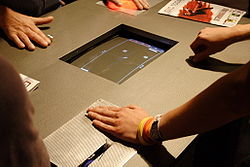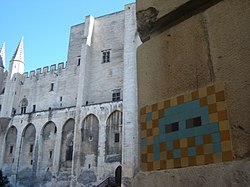Game Art

FineArtPrint Diasec / AluDibond, 100 × 280 cm
Artist: Matthias AK Zimmermann
Location: Computerspielemuseum Berlin

Artist: Tilman Reiff & Volker Morawe
Location: Computerspielemuseum Berlin
Game Art , GameArt , Game-Art (also computer game art) is an art movement that developed at the beginning of the 21st century and explicitly refers to the virtual space of digital game worlds. Game Art is a genre of art that is sub-grouped in media art .
definition
Game artists take computer games as a source of inspiration and derive their own ideas from them, which should reflect the virtual world of digital game worlds. Her works of art do not have to explicitly cite computer games or computer game characters, but can also depict processes of reflection on digital games, virtual landscapes / rooms / figures, game design and the like, which are related to computer games. These works of art inspired by computer games can be created digitally - for example in the form of modified computer games - or in analog form in the form of paintings on canvas, sculptures or the like. Game Art can also overlap with other art forms. For example, the Game Artist Invader belongs to street art as well as game art. The pixel art can be understood as a subset of game art, so far is the art relating to computer games.
Examples of Game Art works of art
The French artist Invader brings mosaic images of characters from the game Space Invaders night anonymously in cities. He started doing this in 1998 in Paris . He later installed his art in other major French cities and then worldwide.
The Swiss artist Matthias AK Zimmermann creates large-format images using programs that are also used in game design. These are implemented as Diasec. His panorama pictures reflect the architecture and development processes of virtual spatial representation. His series of pictures "Der Levelmixer" remedializes computer games into static paintings. The series of images focuses on the history of video games and the source code .
Painstation is a system originally developed as an interactive art object by Tilman Reiff and Volker Morawe, two students at the Art Academy for Media Cologne in 2001. The designers were inspired by the children's game Torture- Mau-Mau and the development of modern computer games . There was a cinematic role model back in 1983 in the James Bond film Never Say Never . In the fictional computer game "Domination" the loser is punished with electric shocks via the joystick. Whoever lets go of the joystick has lost.
Exhibition «GameArt», Völklinger Hütte, 2003/2004
From November 22, 2003 to April 18, 2004, the Völklinger Hütte hosted the GameArt exhibition, which is significant in terms of Game Art and featured international artists whose art explicitly relates to computer games and reflects the virtual space of digital game worlds . In the blower hall with an area of 6,000 m 2 , 37 large artist works / installations were installed between the large machines. The works of art shown there were divided into three categories / subject areas:
- «Player - body - delimitation», which addresses the interface or connection between virtuality and the real world.
- “Play world - space - conquest”, in which works of art are represented which spaces and their options for action are the focus of attention.
- "Role-play - identity - expansion", which addresses the staging of a personality / character in virtual space in order to try out different sides of the self (in the virtual space the person is represented in the form of an avatar).
The creation, further development and marketing of artificial and virtual personalities were also discussed. The works of art shown there were partly generated digitally, while other works of art were of an analog nature and showed installations, modified video games, digitally printed paintings, sculptures, and performance.
Well-known game artists
- Bill Viola (* 1951, USA)
- Björn Melhus (* 1966, Germany)
- Carina Hübner (* 1978, Germany)
- Chiho Aoshima (* 1974, Japan)
- Christoph Draeger (* 1965, Switzerland)
- Cory Arcangel (* 1978, USA)
- Davix (* 1966, Switzerland)
- Fabrizio Plessi (* 1940, Italy)
- Guillaume Reymond (Switzerland)
- Invader (France)
- Jona Hoier (* 1982, Austria)
- Jon Haddock (* 1960, USA)
- Julian Oliver (New Zealand)
- Karin Pichler (* 1980, Austria)
- Kathleen Ruíz (* 1962, USA)
- Kristin Lucas (* 1968, USA)
- Lonnie Flickinger (* 1968, USA)
- Markus Murschitz (* 1982, Austria)
- Mathias Fuchs (* 1956, Austria)
- Matthias AK Zimmermann (* 1981, Switzerland)
- Margarete Jahrmann (* 1967, Austria)
- Max Moswitzer (* 1968, Austria)
- Meike Schmidt (* 1975, Germany)
- Milo Tesselaar (* 1982, Austria)
- Miriam Mone (* 1983, Austria)
- Natalie Bookchin (* 1962, USA)
- Norbert Bayer (Berlin)
- Olaf Breuning (* 1970, Switzerland)
- ParrenoPierre Huyghe (* 1962, France)
- Patrick Jean (France)
- Paul Garrin (* 1957, USA)
- Peggy Ahwesh (* 1954, USA)
- Philippe Parreno (* 1964, Algeria)
- Roman Kirschner (* 1975, Austria)
- Stephan Bergmann (* 1980, Austria)
- Sylvie Fleury (* 1961, Switzerland)
- Sylvia Eckermann (* 1962, Austria)
- Tilmann Reiff (* 1971, Germany)
- Tobias Bernstrup (* 1970, Sweden)
- Volker Morawe (* 1970, Germany)
- Ulrich Reiterer (* 1982, Austria)
- Yves Netzhammer (* 1970, Switzerland)
literature
- Natascha Adamowsky (Ed.): Digital Modernism. Matthias Zimmermann's model worlds . Hirmer Verlag, Munich 2018, ISBN 978-3-7774-2388-3
- Stephan Schwingeler (Ed.): Artwork computer game - digital games as artistic material. An image science and media theoretical analysis . Transcript Verlag, Bielefeld 2014, ISBN 978-3-8376-2824-1
- Meinrad Maria Grewenig , Otto Letze (ed.): GameArt , Hatje Cantz, Ostfildern 2003, ISBN 978-3-7757-9185-4
Web links
- Exhibition Völklinger Hütte: GameArt, 2003/2004 - Exhibition: Völklinger Hütte GameArt 2003/2004 (German & English)
Notes and individual references
- ↑ Meinrad Maria Grewenig, Otto Letze: GameArt Ostfildern: Hatje Cantz, 2003, Onlinepräsents: GameArt
- ↑ http://netzspannung.org/database/139215/de
- ↑ Davis Schrapel: Games Art: The Space Machine 1-3 - Video Games in the Aspect of a “Building Kit World” & The Space Machine 4 - The Perspective of Inspiration and Geometry , 2012, Germany
- ↑ Urs Bugmann: Pictures, perfect like from a computer game & "The constructed atmosphere" , published in Neue Luzerner Zeitung , Switzerland - direct link (PDF; 3.2 MB)
- ↑ Janina Woods: Swiss Game News - Swiss game art , published in games.ch , Switzerland - direct link
- ↑ Simone Schreiber: Limitless Worlds , published in Spielplatz - Games für alle , Germany - direct link (PDF; 5.2 MB), - original source, pp. 50–54
- ↑ On the Media, June 27, 2003, transcript and interview as .mp3 under They Like Pain (Station) ( Memento from August 3, 2007 in the Internet Archive )
- ↑ Meinrad Maria Grewenig, Otto Letze: GameArt Ostfildern: Hatje Cantz, 2003, Onlinepräsents: GameArt
